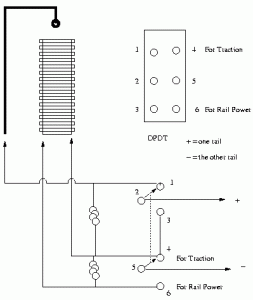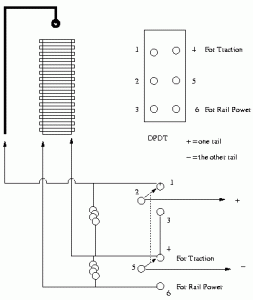Biting off more than I can chew here....
When you build a home or club layout, you can wire it to suite your needs/wants/budget.
If you are operating all of one type of equipment, then you are home free.
In my case, however, I am trying to cover all the bases.
The On30 Modules will need to accomodate all types of motive power.
There will be traction running on the same lines as Heislers, Shays as well as other steam.... There is also room for Diseasels.
In Traction, the layout is wired so that the overhead carries one "+/- pole" of the electrical current and the rails are wired together to be the other "+/- pole".
In regular Two Rail operations, one rail carries one "+/- pole" of the electrical current and the other rail is the other "+/- pole".
The question is.... Is there a way to wire the modules so that I can switch between overhead power and rail power?
Is there a standard for this? i.e.: The right-hand rail and the overhead wire are always the same polarity and the left-hand rail is always the other polarity?
Or, should the Traction equipment get power from the rails and the overhead is just there for decoration????
When you build a home or club layout, you can wire it to suite your needs/wants/budget.
If you are operating all of one type of equipment, then you are home free.
In my case, however, I am trying to cover all the bases.
The On30 Modules will need to accomodate all types of motive power.
There will be traction running on the same lines as Heislers, Shays as well as other steam.... There is also room for Diseasels.
In Traction, the layout is wired so that the overhead carries one "+/- pole" of the electrical current and the rails are wired together to be the other "+/- pole".
In regular Two Rail operations, one rail carries one "+/- pole" of the electrical current and the other rail is the other "+/- pole".
The question is.... Is there a way to wire the modules so that I can switch between overhead power and rail power?
Is there a standard for this? i.e.: The right-hand rail and the overhead wire are always the same polarity and the left-hand rail is always the other polarity?
Or, should the Traction equipment get power from the rails and the overhead is just there for decoration????




